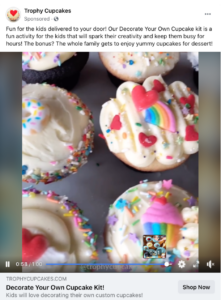Performance marketing, or using paid tactics to drive measurable lead and customer conversions, is nothing new. SaaS and e-commerce companies have been doing it for years. Yet right now, traditionally offline companies are finding that they have to look to performance marketing to survive…not to mention those businesses that have historically straddled the online/offline divide.
Consider the ad below we recently stumbled upon. A local brick-and-mortar Seattle cupcake chain that never did deliveries quickly did a 180. They developed a Decorate Your Own Cupcakes Kit that would arrive right at your door. How did they go about announcing this? Via a digital ad on Facebook with a “Shop Now†call-to-action that leads to an online order form. A purely offline business realized online was the way to go, and quickly spun up their engines to make it happen!

Necessity sure is the mother of invention. But once you invent it, how do you make sure it’s working well and that you’re optimizing your spend as best as possible? Let’s review each step in the performance marketing funnel, and pick apart its pieces, so you can see everything that needs to go right to create a well-oiled, revenue-generating machine.
DEFINING PERFORMANCE MARKETING
First things first, let’s talk about what performance it, and what it isn’t. The simplest way of defining performance marketing is to call it the kind of marketing that is based on pay for performance activities. This generally includes paid activities like Google or Facebook ads that allow you to directly target customers or audiences, measure click-thru metrics, and ultimately track customer or lead conversions back to a particular ad.
This type of marketing is a far cry from branding, which is geared more towards creating the resounding look, feel, and personality of a product, or content marketing, which is leveraged to help drive longer-term awareness and consideration for a product.
Because performance marketing is so metrics driven from start to finish, it affords a business one of the best opportunities to measure and then optimize each step someone takes prior to conversion. Additionally, because it is paid marketing, it’s one of the few types of marketing that lets you cleanly track cash output into an activity relative to its return.
THE DISTINCT PARTS OF THE PERFORMANCE MARKETING CONVERSION FUNNEL
Let’s start by looking at the typical components of any performance marketing funnel. While we won’t get too into the weeds, you’ll see that within each component there are a myriad of elements that need to be worked on to optimize the entire process.
AD PLATFORM SET UP
Each ad platform out there has its own set of complexities and peculiarities. Yet just take a look at the list below, which covers the typical variables you’d have to determine no matter which platform you’re considering, and you’ll start to see that just the ad platform set up alone leaves a lot of variables in place for testing and improvement.
-
Audience or keyword targeting: Deciding which customer segments you want to actually see your ads, based either on demographic and physiographic dimensions and/or search behavior.
-
Geographic focus: Adding a constraint to only show ads to people in certain cities, regions, or countries.
-
Conversion tracking set up: The process of identifying what you’ll be defining as a conversion (e.g. a new customer, a new lead) and programming the platform to be able to record that conversion.
-
UTM tracking protocols: The process of automating the assignment of tracking codes once ads launch so you can track performance at the ad-unit level.
-
Device type: Determining if you want to target people on desktops, tablets, phones, or all of the above.
-
Day-parting: Determining which days, and which times of days, you want to serve ads.
-
Bid approach: Deciding how you want to set your bid, which can include targeting a certain cost-per-click or cost-per-acquisition target, setting a moderated or accelerated spend, and a host of other options.
-
Budgeting: Setting the amount you want to spend on a daily, weekly, or monthly for your entire campaign, and then for unique groups you want to target.
ADVERTISING UNITS
We intentionally separated out the ads from the platform set up because they are so key to the performance marketing experience. After all, this is the very first thing a prospect will see that will (hopefully) compel them to click and ultimately buy.
Depending on the ad platform, the ads themselves vary greatly. Consider the different factors you’d need to consider based on some of the most commonly-used platforms:
-
Facebook / Instagram: Ad unit type (e.g. static image, video, carousel, lead gen), visual element, headline copy, description copy, call-to-action.
-
Google Text Ads: Headline copy, description copy, URL, site link extensions, callout extensions.
-
Google Display/Retargeting Ads: Headline copy, call-to-action, visual element.
-
Outbrain / Taboola Sponsored Content: Title, subtitle, body content, embedded links, call-to-action.
As you can see, no matter which ad platform you’re considering, a variety of factors need to be tackled to effectively move prospects down the conversion funnel.
LANDING PAGES
A landing page refers to the first experience someone has once they land on your website. For most businesses, the landing page someone reaches after clicking on an ad is the homepage. At least, when the business first goes live with performance marketing.
However, this is often problematic because homepages don’t necessarily drive to an immediate conversion. This is because homepages are generally intended to let customers explore and learn more. Sure, they might make a purchase, or they may choose to start reading your content or other on-site materials. This muddy customer journey can result in people exiting your site before they buy or ask for more info.
As a result, using distinct landing pages, single-page experiences that drive to one core behavior, are generally key to pushing people successfully down the funnel. But landing pages themselves can be diverse. They include call-to-actions, testimonials, pricing information, information capture fields and much more. This is why landing page testing is a key part of optimizing the performance marketing funnel. You never know which landing page with which content will drive the most conversions. This means you’ll need to test countless permutations to find ones that increase the odds of prospects moving down the funnel.
FORMS & CHECK OUT PROCESS
How you go about actually collecting information can make or break the conversion process. At this stage, you’ve almost got someone where you need them. But, creating a less-than-ideal checkout or information capture experience can result in them existing before the conversion happens.
This is why evaluating the ways contact and/or credit card information is collected is such a critical part of the performance marketing funnel. Finding ways to ask for as little information as possible while making the process as quick and click-free as is feasible will go a long way to ensuring customers complete the process. However, just like with landing pages, you’ll need to test different form iterations to identify the one that yields the best conversion rate.
POST CONVERSION EMAIL NURTURING
The messages that leads or customers receive once they’ve completed a form also play a key role in improving the performance marketing funnel. This is especially the case in B2B businesses where a form capture may result in gathering someone’s information, or may be the start of a free trial, but not necessarily the final purchase.
Developing email nurturing series that help prospects understand how best to begin using your product and leverage its full feature set, as well as showcasing how other companies have best leveraged the tool, can go a long way to improving the chances of making that final conversion happen. Even in the case of B2C businesses, post conversion emails can help keep prospects excited about their purchase, increasing the chances of improved word of mouth and repurchase.
MEASURING YOUR PERFORMANCE MARKETING EFFORTS
We’ve been talking a lot about optimizing your performance marketing which implicitly means one key thing: you’re actually measuring what’s going on!
So what exactly does that look like? It means two things at a high level:
-
Measuring Conversion Rates At Each Stage: At each of stages listed above, you’ll want to measure the total people that experienced the step and divide it by the total that behaved in the way you wanted them to. This will let you quickly see the conversion rate of each step in your performance marketing funnel.
-
Measuring Conversion Rates for Each Test: As you start honing in on particular steps, you’ll start making changes to different components. After each change, you’ll want to record the updates you made and what impact, if any, they made on conversion rates.
By ensuring the two items above, you’ll be able to measure over time how well your performance marketing efforts are working. Of course, all tests won’t work. That’s okay. By being diligent about measurement, you’ll be able to isolate those poor-performers quickly and boot them out as well as isolate the winners and get them permanently into your mix.
WHERE TO BEGIN OPTIMIZING YOUR PERFORMANCE MARKETING FUNNEL
We just went through the distinct steps that make up a performance marketing funnel from click to purchase. The natural follow-up question is, “Where do I start?†There are a few ways to crack that particular nut:
-
Fill In The Existing Gaps: The easiest place to start is often where you have complete gaps in your funnel. For instance, if you haven’t begun using distinct landing pages or you haven’t implemented any nurturing emails, start there. It’s the fastest way to start seeing conversion rate improvements.
-
Optimize The Biggest Conversion Drop Offs: If you have each discrete step in place, you’ll be able to see the percent of people successfully moving to the next step in the funnel. Said another way, you’ll be able to see where the biggest conversion drop offs exist in your funnel and focus your attention on fixing these areas.
-
Optimize From Top to Bottom: When all else fails, you can always just start from the very top. Work on your ad platform optimization first so that you know you’re spending your money as wisely as possible, and then work your way down the funnel to continue improving each conversion point.
Of course, these choices aren’t mutually exclusive. You can certainly fill in gaps while optimizing existing experiences. Often which choices you make are a product of the resources and bandwidth you have on-hand to implement improvements.






